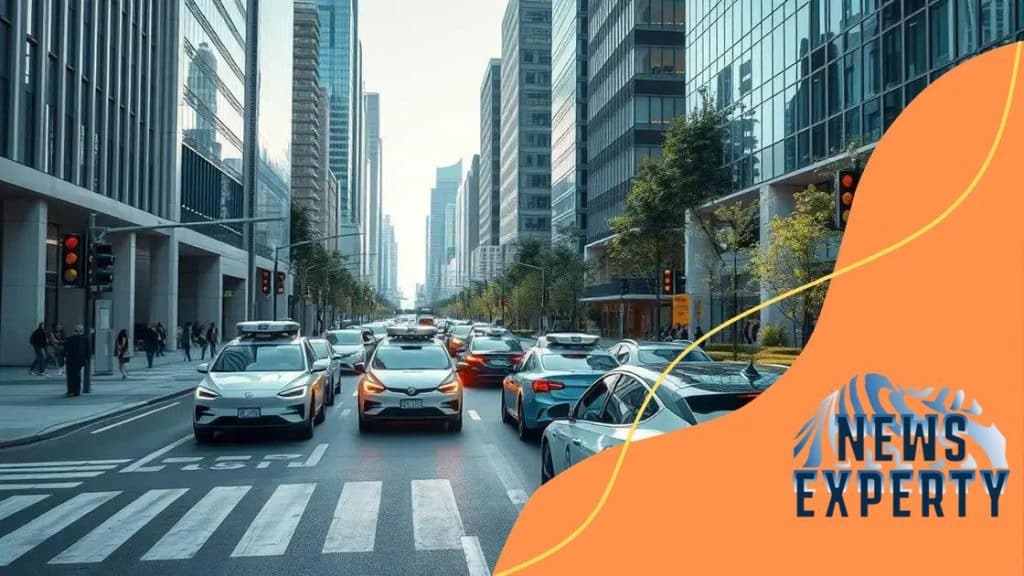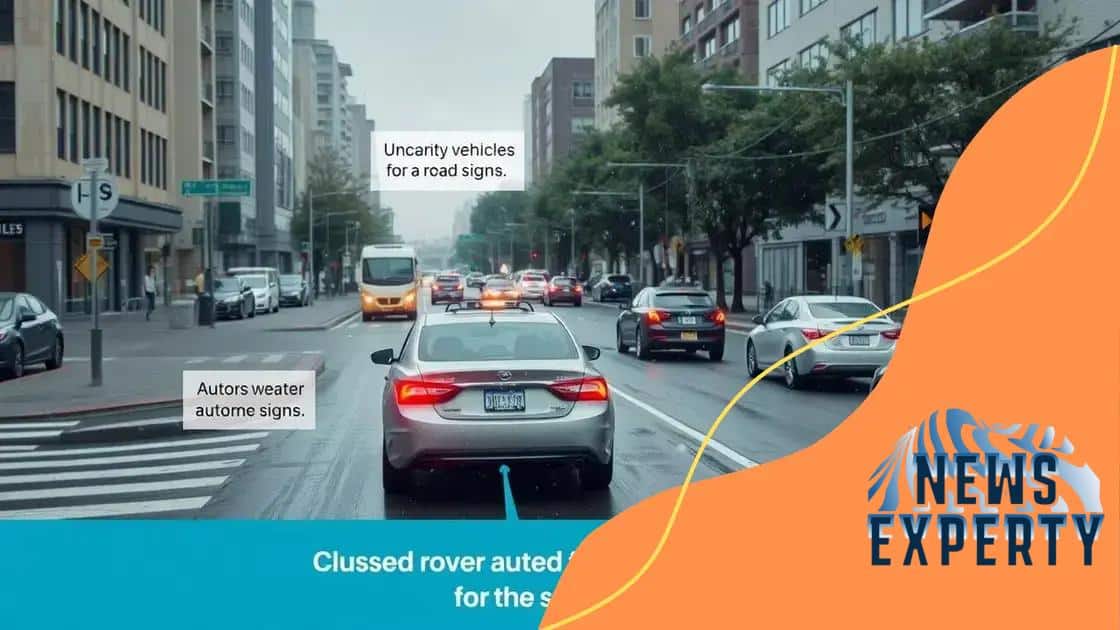The increasing role of autonomous vehicles in urban mobility

Anúncios
The increasing role of autonomous vehicles in urban mobility promises enhanced safety, reduced traffic congestion, and transformed urban infrastructure, paving the way for smarter and more sustainable cities.
The increasing role of autonomous vehicles in urban mobility is reshaping how we think about transportation. Have you ever imagined a world where cars drive themselves? In this article, we’ll delve into how these innovations are changing our daily journeys.
Anúncios
Understanding autonomous vehicles
Understanding autonomous vehicles is essential in today’s rapidly changing transportation landscape. These vehicles, often referred to as self-driving cars, operate without human intervention using a mix of advanced technologies.
How Do Autonomous Vehicles Work?
Autonomous vehicles use sensors, cameras, and artificial intelligence to navigate safely. They gather data from their surroundings to make decisions in real time. This technology allows them to detect obstacles, recognize road signs, and interact with traffic.
Key Technologies Behind Autonomous Vehicles
Several critical technologies enable autonomous driving. These include:
Anúncios
- LiDAR (Light Detection and Ranging): This laser-based technology creates a 3D map of the vehicle’s surroundings.
- Computer Vision: This system interprets camera images to identify objects on the road.
- Radar: This technology helps detect the speed and distance of nearby objects.
- AI Algorithms: These processes help vehicles make complex decisions based on data from various sensors.
As we explore the realm of autonomous vehicles, it’s fascinating to see how they adapt to different driving conditions. They can navigate complex urban environments and adjust their behavior based on traffic patterns. This flexibility is one of the main reasons experts believe they will significantly improve urban mobility.
However, understanding the implications of implementing these vehicles in our cities is vital. They promise to enhance safety by reducing the number of accidents caused by human error. Additionally, they can optimize traffic flow and reduce congestion. As cities adapt to these changes, planners will need to consider how to integrate autonomous vehicles into existing infrastructures.
The widespread adoption of autonomous vehicles may also reshape urban design. We could see less need for parking spaces, leading to more green areas and pedestrian-friendly zones. This shift could ultimately improve the quality of life in our cities.
Benefits of autonomous vehicles in cities
The benefits of autonomous vehicles in cities are vast and impactful. These vehicles have the potential to change how we think about transportation, making urban areas safer and more efficient.
Improved Safety
One of the major advantages of autonomous vehicles is the promise of safer roads. Most accidents are caused by human errors, such as distracted driving or speeding. By removing the human factor, we can significantly reduce accident rates. Self-driving cars use advanced sensors to detect their surroundings and can react faster than human drivers.
Enhanced Traffic Flow
Another significant benefit is improved traffic flow. Autonomous vehicles can communicate with each other to optimize routes and reduce congestion. This teamwork allows for better traffic management, leading to smoother rides and shorter travel times.
- Dynamic routing to avoid congestion
- Coordinated acceleration and braking
- Reduction of stop-and-go traffic
- Increased utilization of existing roadways
Additionally, these vehicles can adapt to real-time traffic conditions, finding the quickest paths to their destinations. This capability helps everyone on the road, not just those in self-driving cars.
Furthermore, autonomous vehicles can contribute to environmental sustainability. Many of these vehicles are electric and can help decrease emissions and reliance on fossil fuels. By optimizing driving patterns, they can also reduce energy consumption, making cities cleaner and healthier.
Finally, the adoption of autonomous vehicles can lead to a reduction in the need for parking spaces. With fewer cars on the road or vehicles that can drop off passengers and find parking far away, cities can reclaim valuable land for parks, community spaces, and bike lanes. This shift can enhance the overall quality of life for urban residents.
Challenges facing autonomous vehicle adoption

The challenges facing autonomous vehicle adoption are significant and multifaceted. While the benefits are clear, various hurdles must be overcome for these vehicles to become commonplace in our cities.
Regulatory Hurdles
One major obstacle is the lack of comprehensive regulations for autonomous vehicles. Governments are still figuring out how to create laws that ensure safety while encouraging innovation. This uncertainty can slow down the development and deployment of such technologies.
Public Acceptance
Another challenge is gaining public acceptance. Many people feel uneasy about riding in a vehicle controlled by a computer. Concerns about safety and reliability can hinder trust in these technologies. Education and transparent communication will be key to alleviating these fears.
- Showcasing safety data and test results
- Involving the public in the development process
- Creating awareness campaigns about benefits
- Offering trials and demonstrations
Additionally, technological challenges remain. The sensors and systems in autonomous vehicles must be perfect for the vehicles to operate safely in all conditions. Bad weather can impact sensor effectiveness, which might lead to accidents if not managed properly. Continuous advancements in technology are crucial to tackle these issues, ensuring the systems can function reliably.
Finally, infrastructure plays a significant role in the successful adoption of autonomous vehicles. Many cities need updates to their current road systems to accommodate these vehicles. This might include smart traffic signals and dedicated lanes to improve efficiency and safety. Without the proper infrastructure, even the best vehicles may face challenges in navigating urban environments.
The future of urban transport with autonomy
The future of urban transport with autonomy promises exciting changes that could reshape our cities. Today, we are on the brink of a transportation revolution, where self-driving cars and smart technologies will play a vital role in our daily lives.
Integration with Public Transport
One key aspect of this future is the seamless integration of autonomous vehicles with public transport systems. Self-driving shuttles could complement buses and trains, creating a comprehensive network that covers more areas efficiently. This integration can lead to:
- More flexible transport options for users
- Reduced wait times for public transport
- Improved access to underserved neighborhoods
- Enhanced environmental sustainability by minimizing traffic
In many urban areas, combining autonomous vehicles with existing public transport can create a more cohesive transit system, reducing congestion and pollution.
Innovation in City Planning
As we look forward, city planners will have to rethink space utilization. The rise of autonomous vehicles means there may be less need for vast parking lots. Cities can reclaim these spaces for parks, recreational areas, or bike lanes, fostering a healthier environment. By reducing the space required for parking, urban areas can become more pedestrian-friendly.
Furthermore, autonomous vehicles can help optimize urban landscapes by enhancing mobility. With less traffic congestion and improved safety, cities will be more accessible and enjoyable for residents and visitors alike.
As technology continues to advance, we may also see a shift towards shared autonomous fleets. This concept could lead to more people using shared services, decreasing individual car ownership. A future where most people rely on shared self-driving vehicles could reduce the number of cars on the road, resulting in cleaner air and less strain on urban infrastructure.
Impact on infrastructure and urban design
The impact of autonomous vehicles on infrastructure and urban design is profound and transformative. As self-driving cars become more common, cities will need to adapt to accommodate this new mode of transportation.
Redesigning Roadways
With the rise of autonomous vehicles, roadways can be redesigned for efficiency and safety. These vehicles can communicate with each other and traffic signals, allowing for smoother traffic flow. Roadways may incorporate features like:
- Dedicated lanes for autonomous vehicles
- Smart traffic signals that adjust in real-time
- Reduced speed limits in high-traffic areas
- Enhanced signage that communicates with vehicles
By redesigning roadways in this way, cities can minimize congestion and enhance safety for all users, including cyclists and pedestrians.
Revamping Parking Solutions
Parking spaces will also undergo a dramatic transformation. Autonomous vehicles can drop off passengers at their destinations and park themselves in less crowded areas. This will reduce the need for large parking lots in prime urban locations. Instead, land can be repurposed for parks, plazas, or community spaces that improve the urban environment.
Many urban planners are excited about converting former parking spaces into green areas. More trees and plants can lead to healthier, more attractive cities.
Smart Infrastructure Development
As autonomous vehicles become more prevalent, cities will increasingly rely on smart infrastructure. This includes:
- Connected sensors that provide data on road conditions
- Real-time monitoring systems to improve safety
- Integrated public transport solutions that align with autonomous vehicle routes
- Data-driven decision-making for urban planning
This intelligent infrastructure can facilitate efficient transportation and enhance the overall living experience in urban areas.
The integration of autonomous vehicles will push cities to invest in advanced technologies that improve connectivity and responsiveness. As cities evolve, they will become more adaptive to the needs of their residents.
FAQ – Frequently Asked Questions about Autonomous Vehicles in Urban Mobility
How will autonomous vehicles improve safety in cities?
Autonomous vehicles can reduce accidents caused by human errors, as they use advanced sensors and algorithms to make safer driving decisions.
What are the environmental benefits of using autonomous vehicles?
They can lower emissions by optimizing driving patterns and can often be electric, contributing to cleaner air quality in urban areas.
How will autonomous vehicles impact urban infrastructure?
Cities may need to redesign roadways, repurpose parking spaces, and implement smart infrastructure to accommodate the needs and benefits of autonomous vehicles.
Will public transportation change with the introduction of autonomous vehicles?
Yes, autonomous vehicles can integrate with public transport systems, offering more flexible options and potentially reducing reliance on personal vehicles.





